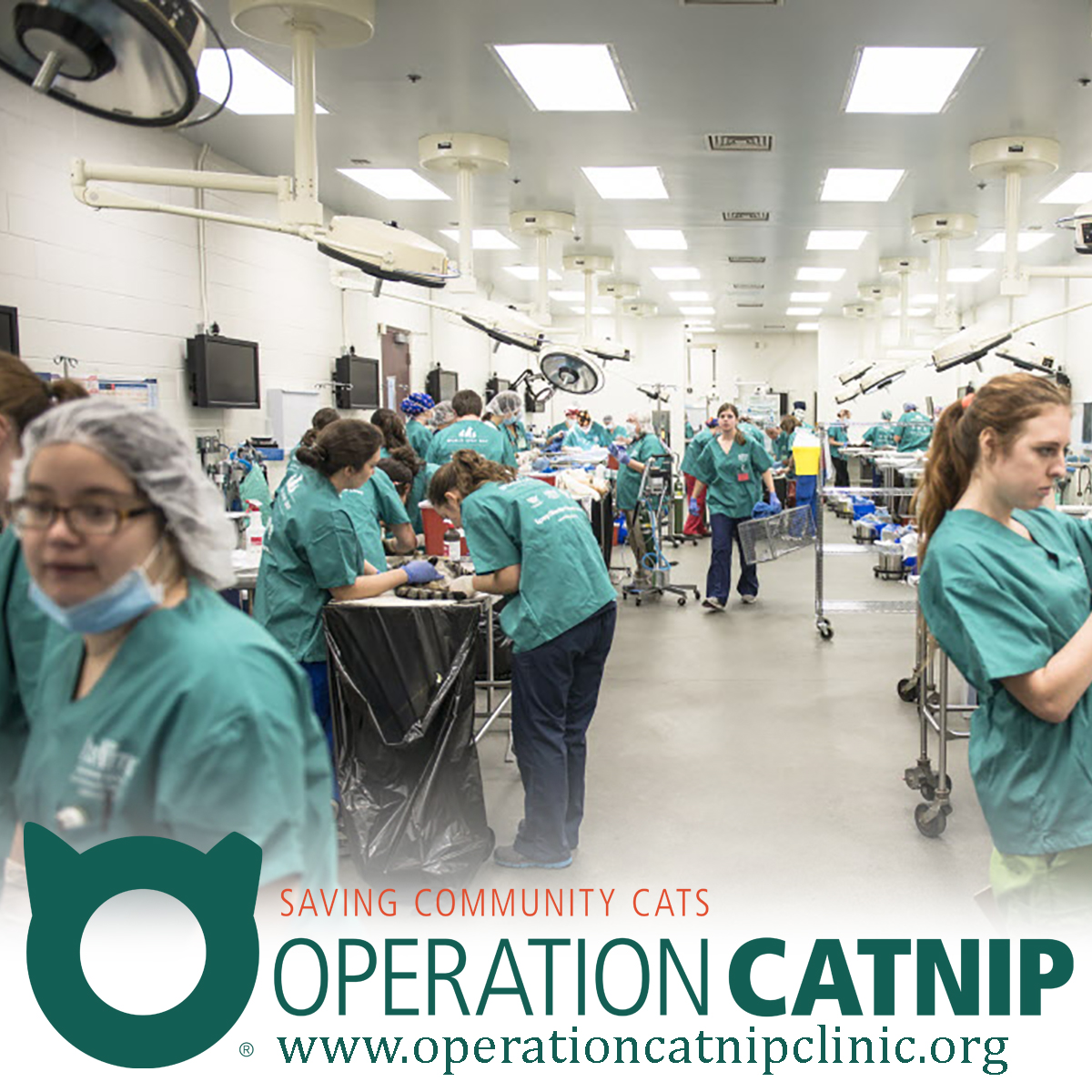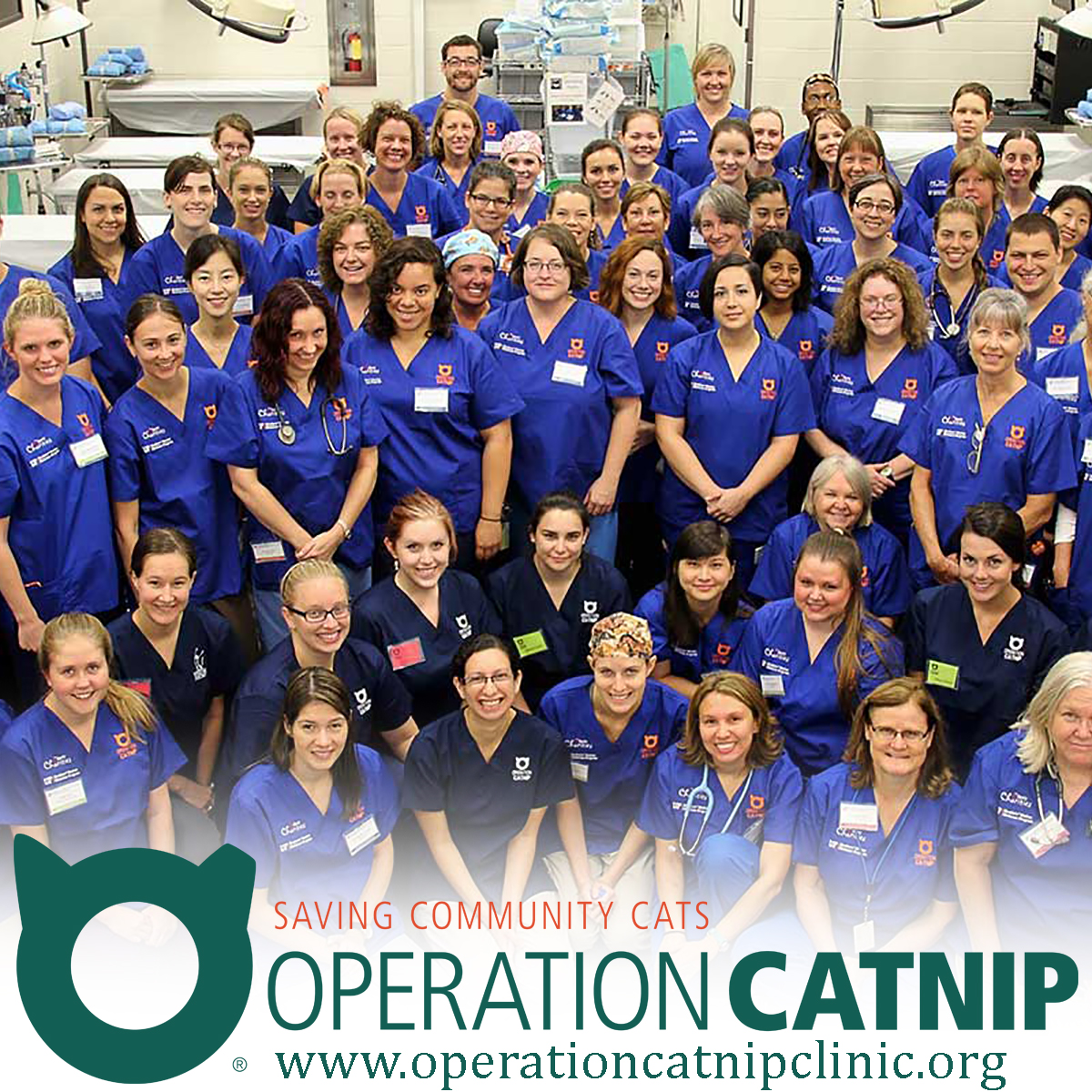Operation Catnip Trains Veterinarians to Save America’s Community Cats

Right now, before we are overrun with kittens, it’s time to plan seriously for reducing the populations of homeless cats before they are even born, and the only way to do that is to spay and neuter every cat who lives outdoors but doesn’t have an indoor home along with those cats who do.
I’ve described the process and effort that goes into each TNR clinic, whether it’s for feral cats only or a mix of rescued, owned and feral cats, and anyone can tell it’s not like taking your cats to your veterinarian to be spayed or neutered. Not the actual care they get—the handling, spay or neuter, vaccines and after care are all about the same, but at a much higher volume including a whole room of veterinarians and technicians, another room of volunteers, and a whole day of spays and neuters, often 100 or more during the busiest summer months. And the ear-tip too, that’s different.
High volume spay and neuter clinics actually begin months before in planning and scheduling veterinarians and technicans and volunteers, weeks before scheduling appointments and planning trapping strategies and days before actually trapping and then finally transporting, treating the cats, letting them recover and either releasing them or taking them to a foster home depending on their status.
Though all veterinarians learn spaying and neutering, the most basic surgeries they’ll be doing through most of their career, the number of cats and the time constraints at a high-volume clinic require the work to be done quickly but still safely, not to mention the unexpected needs that arise with a certain number of cats. At almost every clinic are infected eyes that need to be removed, injured limbs to be amputated, tooth extractions, wounds to suture, sometimes even cancerous growths to remove, all at the same pace as the rest of the activity. That’s a skill that only comes with practice, and learning a number of surgical techniques that can make the surgeries easier and quicker but still safe makes it possible.
According to a March 9 press release, founded by Dr. Julie Levy, director of the Maddie’s Shelter Medicine Program at the University of Florida College of Veterinary Medicine, the trap-neuter-return (TNR) program known as Operation Catnip has been running free high-quality, high-volume spay/neuter clinics for community cats in Gainesville for more than 16 years, caring for for more than 45,000 cats in that time.
Through an educational grant from PetSmart Charities, Operation Catnip is making their training program and materials available to veterinarians, veterinary students, and veterinary technicians all over the U.S.
“Our vision is to train an army of veterinarians to spay and neuter America’s community cats,” said Levy. “This approach, along with vaccination, will allow us to reduce cat population, control infectious diseases, and improve the lives of the cats.”

Operation Catnip clinics are operated much like the Homeless Cat Management Team clinics I’ve described here in Pittsburgh but all volunteers are veterinarians, veterinary technicians, and veterinary students. The cats are trapped and taken to the clinic by colony caretakers or volunteers where they’re cared for in staffed stations equipped with surgical materials: examined, spayed or neutered, vaccinated against infectious diseases, treated for fleas and other parasites, given an identifying ear tip, allowed to recover, then returned to the location where trapped.
Program veteran Dr. Catherine McManus is now operations manager for Dallas Animal Services, which recently made news for providing care for Bentley, the dog of nurse Nina Pham, during his Ebola quarantine.
“Dr. Levy’s mentoring and the work she was doing inspired me to complete a shelter medicine residency,” McManus said. “That education and experience have made it possible for me to do the work I do today here in Dallas, including being an advocate for community cats and TNR.”
Another veterinarian who found the Operation Catnip experience life-changing is Dr. Amy Karls, who volunteers her services with four different community cat organizations in Massachusetts in addition to her fulltime veterinary career.
“I was able to bring everything I learned back to our local rescue and TNR groups,” said Karl. “It was truly wonderful to see so many people united for the common goal of improving the lives of the homeless cat population.”
To learn more about Operation Catnip, or sign up for one of their upcoming training sessions, visit www.operationcatnipclinic.org.
Hopefully someday very soon cats living outdoors after being abandoned by humans and the generations of cats born to them will receive the care that all cats deserve, and populations will finally decrease.
About Operation Catnip
Operation Catnip is a 501(c)(3) nonprofit project dedicated to saving the lives of community cats by providing community-based high-quality, high-volume spay/neuter services as well as training opportunities for veterinary professionals and students from across the U.S. Visit operationcatnipclinic.org for more information.
PetSmart Charities
PetSmart Charities is a nonprofit animal welfare organization that saves the lives of homeless pets. More than 400,000 dogs and cats find homes each year through their adoption program in all PetSmart® stores and their sponsored adoption events. PetSmart Charities grants more money to directly help pets in need than any other animal welfare group in North America. The focus is on funding spay/neuter programs that help communities solve pet overpopulation. PetSmart Charities is a 501(c)(3) organization, separate from PetSmart, Inc.
Images and video provided by Operation Catnip
Read more articles about Health and Safety and Veterinary Medicine.
All images used on this site are copyrighted to Bernadette E. Kazmarski unless otherwise noted and may not be used without my written permission. Please ask if you are interested in using one in a print or internet publication. If you are interested in purchasing a print of this image or a product including this image, check my Etsy shop or Fine Art America profile to see if I have it available already. If you don’t find it there, visit Ordering Custom Artwork for more information on a custom greeting card, print or other item.



What a wonderful organization! The people caring for ferals really need help like this. I wish we had some help for ferals around here. I’ve had several local people ask me who can help them as they care for ferals and I don’t really have anywhere to send them. The one rescue in the area that works with TNR is totally overwhelmed. Hopefully Operation Catnip will inspire similar programs around the country.